 W
WThe hermits are tropical and subtropical hummingbirds in the subfamily Phaethornithinae, comprising 30–40 species in six genera. They occur from southern Mexico, through Central America, to South America as far south as northern Argentina.
 W
WHummingbirds are birds native to the Americas and constituting the biological family Trochilidae. They are the smallest of birds, most species measuring 7.5–13 cm (3–5 in) in length. The smallest extant hummingbird species is the 5 cm (2.0 in) bee hummingbird, which weighs less than 2.0 g (0.07 oz). The largest hummingbird species is the 23 cm (9.1 in) giant hummingbird, weighing 18–24g (0.63–0.85 oz).
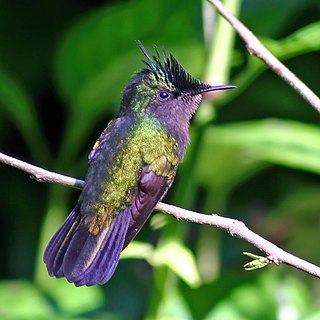 W
WThe International Ornithological Congress (IOC) recognizes these 360 hummingbird species in family Trochilidae, and distributes them among 112 genera. Two extinct species known only from 19th century specimens, Brace's emerald and Gould's emerald, are included. This list is presented in IOC taxonomic sequence and is also sortable alphabetically by common name and binomial name.
 W
WOrder: Apodiformes Family: Trochilidae
 W
WTrochilinae is a subfamily of the hummingbird family (Trochilidae). Members of the subfamily Trochilinae are sometimes called typical hummingbirds. They typically display iridescent plumage in metallic reds, oranges, greens and/or blues. Strong sexual dimorphism in plumage and size is evident in many species.
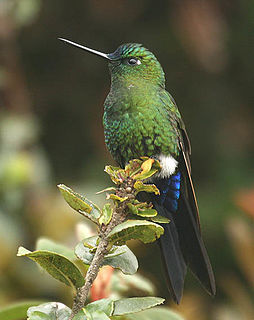 W
WThe pufflegs are hummingbirds from the genera Eriocnemis and Haplophaedia. They occur in humid forest, woodland and shrub at altitudes of 1000 to 4800 m. asl in the Andes of Argentina, Bolivia, Peru, Ecuador, Colombia, and Venezuela. The males have a colorful green, coppery or blue plumage, and the females are generally somewhat duller. The most striking feature of both sexes is their dense snow-white leg puffs which consist of feather tufts that resemble woolly panties. One species - the black-thighed puffleg - is characterized by black coloured leg puffs, and another - the buff-thighed puffleg - has lightly buff-tinged leg puffs. Further common features of all species are the straight black bill and the slightly to deeply forked tail. The members of the genus Haplophaedia are generally duller than the members of Eriocnemis.
 W
WThe black-throated brilliant is a species of hummingbird in the family Trochilidae. It is found in Brazil, Colombia, Ecuador, and Peru. Its natural habitats are subtropical or tropical moist lowland forest and subtropical or tropical moist montane forest.
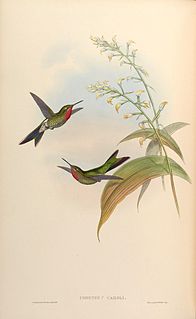 W
WThe bronze-tailed comet is a species of hummingbird in the family Trochilidae. It is monotypic within the genus Polyonymus. It is endemic to scrub and forest-edge at altitudes of 2,100–3,400 m (6,900–11,200 ft) in the Andes of Peru.
 W
WCalliphlox is a genus of hummingbird in the family Trochilidae.
 W
WCalothorax is a genus of hummingbird in the family Trochilidae. It contains the following species:
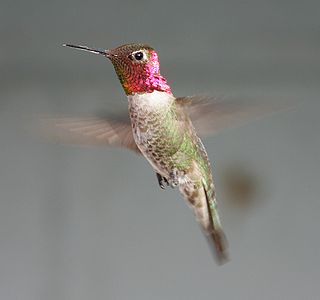 W
WCalypte is a genus of hummingbirds. It consists of two small species.
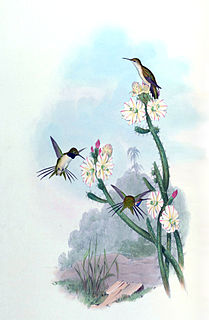 W
WThe Chilean woodstar is a small bird in the hummingbird family, Trochilidae. It is restricted to northernmost Chile with reports from southern Peru. Its natural habitats are dry shrubland and rural gardens. It is threatened by habitat loss and is classed as a critically endangered species. It is usually classified in its own genus Eulidia, but is sometimes placed with the purple-collared woodstar in the genus Myrtis. In 2013, it was classed as endangered, but recently, it was classed as critically endangered by the IUCN Red List.
 W
WChlorostilbon is a genus of hummingbird in the family Trochilidae, known as emeralds. A single species, the blue-chinned sapphire is variously placed in the monotypic genus Chlorestes or in Chlorostilbon. The taxonomy of the C. mellisugus superspecies is highly complex and, depending on view, includes 1-8 species. All species in this genus have straight black or black-and-red bills. The males are overall iridescent green, golden-green or bluish-green, and in some species the tail and/or throat is blue. The females have whitish-grey underparts, tail-corners and post-ocular streak.
 W
WDiscosura is a genus of hummingbird in the family Trochilidae. The thorntails are sometimes placed in the genus Popelairia, leaving Discosura for the racket-tailed coquette. On the contrary, some have argued for merging this genus into Lophornis, which they overall resemble, except for the highly modified tail-feathers of the males.
 W
WThe red-billed streamertail, also known as the doctor bird, scissor-tail or scissors tail hummingbird, is indigenous to Jamaica, where it is the most abundant and widespread member of the hummingbird family. While most authorities now consider it a separate species, some continue to consider it conspecific with the black-billed streamertail. The red-billed streamertail is the national bird of Jamaica.
 W
WThe grey-bellied comet is a species of hummingbird in the family Trochilidae. It is found only in a few small areas of Peru. Its natural habitats are subtropical or tropical high-altitude shrubland and rural gardens. It is threatened by habitat loss.
 W
WHeliodoxa is a genus of hummingbird in the family Trochilidae. It contains the following species:Gould's jewelfront, Heliodoxa aurescens Fawn-breasted brilliant, Heliodoxa rubinoides Violet-fronted brilliant, Heliodoxa leadbeateri Velvet-browed brilliant, Heliodoxa xanthogonys Black-throated brilliant, Heliodoxa schreibersii Pink-throated brilliant, Heliodoxa gularis Rufous-webbed brilliant, Heliodoxa branickii Empress brilliant, Heliodoxa imperatrix Green-crowned brilliant, Heliodoxa jacula
 W
WHummingbirds is a large format, fine art book coffee table book about hummingbirds written by John C. Arvin, with 212 illustrations of hummingbirds in their habitat, and published in 2016. The book is published by Gorgas Science Foundation in the United States of America and Felis Creations in India.
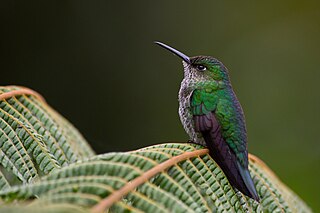 W
WThe many-spotted hummingbird is a species of hummingbird in the family Trochilidae. It is the only member of the genus Taphrospilus, but is sometimes placed in Amazilia or Leucippus instead.
 W
WThe mountain velvetbreast is a species in the family Troochiidae, the family to which all hummingbirds belong. It is the only member of its genus and is found in the Andes, mostly between 2400 and 3500 m, of northwestern Venezuela, Colombia, Ecuador, and Peru. Its natural habitats are clearings and bushes at the edges of subtropical or tropical moist montane forests and heavily degraded forests.
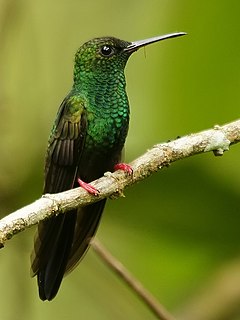 W
WThe plumeleteers are a group of hummingbirds in the genus Chalybura. It contains the following species:
 W
WWoodnymphs are hummingbirds in the genus Thalurania. Males are green and violet-blue, while females are green with white-tipped tails and at least partially whitish underparts. Both sexes have an almost straight, entirely black bill and little or no white post-ocular spot. They are found in forest and tall second growth. The species in this genus are almost entirely allo- or parapatric, and a species is present virtually everywhere in the tropical humid Neotropics.